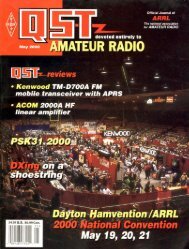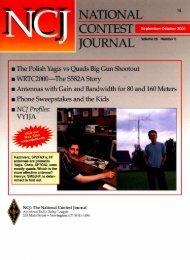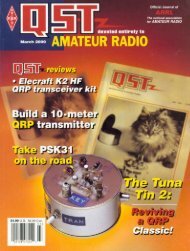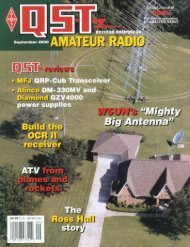Create successful ePaper yourself
Turn your PDF publications into a flip-book with our unique Google optimized e-Paper software.
“take-off” angle—reported by the two<br />
programs. This difference is largely due to<br />
the complexity of the calculations involved<br />
as well as where and how a given program<br />
does its rounding from the long string of<br />
digits that computers use in their calculations.<br />
Also note that there is a 0.03-dB<br />
difference in reported gain, which is also<br />
insignificant. Of far greater importance is the<br />
pattern shape—a broad oval. Signals off the<br />
ends of the antenna will be weaker than those<br />
broadside to the antenna, but they may still<br />
be strong enough for contacts. The classic<br />
figure-8 pattern is nowhere to be seen. The<br />
reason is the relative closeness of the antenna<br />
to the ground.<br />
Before we leave the model, let’s look at<br />
the source impedance data available as a<br />
table in most programs. The impedance<br />
listed is not the classic 72 Ω resistive that<br />
we associate with a resonant dipole.<br />
Instead, it is about 91 + j 20 Ω. The original<br />
cutting formula that we used to create our<br />
dipole model turns out to yield an antenna<br />
that is too long, as indicated by the<br />
inductive reactance at the feed point/source.<br />
As well, the resistive part of the impedance<br />
is considerably above the number used as<br />
the dipole standard. The numbers generated<br />
by NEC may be surprising. Nonetheless,<br />
they are accurate within the limits of the<br />
program, with its homogenous ground and<br />
clutterless field for the radiation.<br />
Even though our main purpose in this<br />
episode was to get oriented to and started<br />
with antenna modeling, that does not mean<br />
that we can’t discover some things about<br />
antennas—even using the simplest antenna<br />
possible. Even the most familiar antennas<br />
have new things to teach us about their<br />
behavior, and antenna modeling is a good<br />
way to learn them.<br />
There remains much to be said about<br />
creating models out of wires and segments.<br />
The more complex the antenna structure,<br />
the more careful we must be. As well, we<br />
should look more closely at the information<br />
that the azimuth and elevation patterns can<br />
present to us, including some pitfalls to<br />
avoid. Next month we’ll look more closely<br />
at the “ins” and “outs” of NEC. 7<br />
Notes<br />
1 Public domain MININEC is available in the<br />
following programs (with Web URLs listed):<br />
NEC4WIN (Windows) from Orion: http://<br />
www.cam.org/~mboukri.<br />
ELNEC (DOS) from W7EL: http://www<br />
.eznec.com.<br />
Another version still used by numerous<br />
modelers is AO from K6STI. AO is a DOS<br />
program. For information e-mail k6sti@n2<br />
.net.<br />
Expert MININEC is a proprietary program<br />
available at various levels from E.M.<br />
Scientific: http://www.emsci.com/.<br />
2 See the following references to using<br />
MININEC in ARRL publications:<br />
John S. Belrose, “Modeling HF Antennas<br />
with MININEC—Guidelines and Tips from a<br />
Code User’s Notebook,” The ARRL Antenna<br />
38 <strong>November</strong> <strong>2000</strong><br />
Compendium, Vol. 3, pp 156-164.<br />
L. B. Cebik, “A Beginner’s Guide to Using<br />
Computer Antenna Modeling Programs,”<br />
The ARRL Antenna Compendium, Vol. 3,<br />
pp 148-155.<br />
Roy Lewallen, “MININEC: The Other<br />
Edge of the Sword,” <strong>QST</strong> (February, 1991),<br />
18-22.<br />
The latter two items are republished in<br />
Vertical Antenna Classics.<br />
3<br />
For a succinct history of method of moments<br />
programs for antenna analysis, see R. P.<br />
Haviland, “Programs for Antenna Analysis<br />
by the Method of Moments,” The ARRL<br />
Antenna Compendium, Vol. 4, pp 69-73.<br />
4<br />
There are at least three commercial implementations<br />
of NEC-2 readily available to<br />
amateurs at reasonable prices:<br />
EZNEC 3.0 (Windows) from W7EL:<br />
http://www.eznec.com (reviewed in the<br />
September <strong>2000</strong> <strong>QST</strong> “Short Takes”).<br />
NEC-Win Plus (Windows) from Nittany<br />
Scientific: http://www.nittany-scientific.<br />
com.<br />
Antenna Solver (Windows) from Grating<br />
Solver Development Co: http://www<br />
.gsolver.com/<br />
5 The actual equations used in developing<br />
antenna characteristics are available in the<br />
NEC-2 manuals. Although most users<br />
encounter only the final “Users” volume, the<br />
foundational volumes are available on-line at<br />
http://www.qsl.net/wb6tpu/swindex.html<br />
and at http://members.home.net/NEC2.<br />
6<br />
In MININEC, the fundamental point of concern<br />
is not within the segment, but at segment<br />
junctions, called pulses. Hence, to center a<br />
source on a wire element, we would use an<br />
even number of segments and specify the<br />
centered junction as the source location.<br />
7 Those interested in pursuing each facet of<br />
basic NEC modeling more thoroughly may<br />
wish to consult Basic Antenna Modeling: A<br />
Hands-On Tutorial, available from Nittany<br />
Scientific (http://www.nittany-scientific<br />
.com). Although written to accompany NEC-<br />
Win Plus, with about 300 exercise files in<br />
.NEC format, the volume can be used with<br />
other implementations. A disk holding all of<br />
the exercise files in .EZ format for use with<br />
EZNEC is available from AntenneX (http://<br />
www.antennex.com).<br />
You can contact the author at 1434 High<br />
Mesa Dr, Knoxville, TN 37938-4443;<br />
cebik@utk.edu.<br />
STRAYS<br />
<strong>QST</strong> Congratulates…<br />
◊ 75 Year Member<br />
Robert Reid, W4TK, Jacksonville, FL<br />
70 Year Members<br />
Kenneth Gardner, W2BGN, Walworth, NY<br />
Alfredo Sambolin, KP4CI, Ponce, PR<br />
Wayne Cooper, AG4R, Alexandria, VA<br />
John Holmes, Jr, W6BUY, Reno, NV<br />
60 Year Members<br />
Robert White, W1CW, Seffner, FL<br />
Robert Wallace, W1HH, Chelmsford, MA<br />
A. Warren Nelson, W1LWB, Hope, RI<br />
William Beal, Jr, W1PNR, Jackson, NH<br />
Fred Albert, W1QP, Fort Myers, FL<br />
Arnold Wilson, N2EZ, Audubon, NJ<br />
Orion Arnold, W2HN, Ho Ho Kus, NJ<br />
Harrison Moore, Jr, W2JQS, Bronxville, NY<br />
Herbert Klein, W2NCM, Brooklyn, NY<br />
Edwin Kephart, W2SPV, Pennsauken, NJ<br />
P. S. Christaldi, W2TF, Montclair, NJ<br />
Douglas Morick, W3NNT, Ocala, FL<br />
Michael Loria, K4CD, Fort Myers, FL<br />
John Pearson, KE4CR, Melbourne, FL<br />
Marc Molyneux, Jr, N4EM, Mobile, AL<br />
Marshall Goldblatt, W4EMB, Miami, FL<br />
John Spark, W4LHP, Lakeland, FL<br />
Lyman Treaster, W6IFC, Visalia, CA<br />
Joseph Roark, W6JGI, Solvang, CA<br />
John Kemper, W6JN, Torrance, CA<br />
Veikko West, K6ORP, San Mateo, CA<br />
George Badger, W6TC, Portola Valley, CA<br />
Howard Shepherd, Jr, W6US, McArthur, CA<br />
Robert Roberts, K6VK, Livingston, TX<br />
Emmett Freitas, AE6Z, San Jose, CA<br />
Robert Leo, W7LR, Bozeman, MT<br />
James Young, W7JL, Long Beach, CA<br />
Nelles Roth, W8UPR, Wauseon, OH<br />
Wayne Flickinger, W9BKJ, Marietta, GA<br />
50 Year Members<br />
Anthony Fiore, W1LKM, Center Ossipee, NH<br />
Guy Gianino, W1OPI, Lynn, MA<br />
Samuel Strauss, W1SS, Royal Palm Beach, FL<br />
Max Norman, W2IQE, Winter Haven, FL<br />
Joseph Flaherty, K2IQM, Port Washington, NY<br />
John Bann, Jr, W2KPV, Garden City, NY<br />
Donald Field, W2UAE, Lawrenceville, NJ<br />
Emery Flinn, Jr, N4DX, Carrollton, GA<br />
Frederick Ritter, W4FI, Longwood, FL<br />
Paul Van Nostrand, W4HVD, Tallahassee, FL<br />
Elbert Wood, W4JFL, Lithia Springs, GA<br />
Frank Butler, Jr, W4RH, Fort Walton Beach,<br />
FL<br />
Wallace Borger, W4VBZ, Trussville, AL<br />
Morris Guzick, W5IO, Sherman, TX<br />
Daniel Droemer, W5KUV, Houston, TX<br />
James Cotten, W5PYI, Weatherford, TX<br />
Fred Ellis, AC5SO, Edinburg, TX<br />
Dean Manley, KH6B, Hilo, HI<br />
Salvatore Teresi, W6EOA, Los Altos, CA<br />
Jay O’Brien, W6GO, Rio Linda, CA<br />
Charles Allessi, W6IEG, Oakhurst, CA<br />
Carl Stengel, W6JEO, Goleta, CA<br />
Paul Williams, W6LHY, Bishop, CA<br />
Stanley Andrews, Jr, K6MO, San Carlos, CA<br />
Sam Lalande, W6OXX, Mammoth Lakes, CA<br />
Donald Burr, AJ6X, Fresno, CA<br />
Herbert Hoover, III, W6ZH, San Marino, CA<br />
Clifford Kurtz, N6ZU, Stockton, CA<br />
Hobart Paine, K7CC, Tucson, AZ<br />
W. Dean Figgins, WA7EPU, La Mesa, NM<br />
James Groll, W7KRW, Avilla, IN<br />
Norman Ray, W7LFA, Kirkland, WA<br />
John Swafford, II, W7MEU, Seattle, WA<br />
H. W. Middleton, Jr, W8CXD, Forest, VA<br />
Kenneth Humbert, W9EDU, Michigan City, IN<br />
Leroy Stalions, K9IEY, West Frankfort, IL<br />
Adolph Jelen, W9IT, Marengo, IL<br />
Edmond Metzger, W9PRN, Springfield, IL<br />
Paul Ripple, W9SIZ, West Bend, WI<br />
Edward Martinson, W0GYH, Mounds View,<br />
MN<br />
Edward Hardt, W0JS, Minneapolis, MN<br />
William Kordik, W0LDO, St. Louis, MO<br />
Emanuel Block, W0PIG, St. Paul, MN<br />
David Robb, W0YRN, Salina, KS<br />
Next Stray<br />
FEEDBACK<br />
◊ Please refer to Rick Littlefield, K1BQT,<br />
“A Wide-Range RF-Survey Meter,” <strong>QST</strong>,<br />
Aug <strong>2000</strong>, p 44, Figure 1. The 0.1 µF capacitor<br />
near C5 should be labeled C6, not<br />
C1.—tnx Rick Littlefield, K1BQT<br />
Next Feedback

















